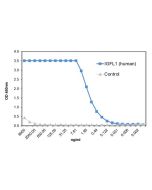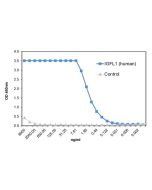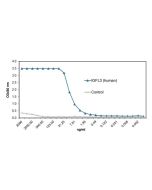Cookie Policy: This site uses cookies to improve your experience. You can find out more about our use of cookies in our Privacy Policy. By continuing to browse this site you agree to our use of cookies.
AdipoGen Life Sciences
IGFL4 (human) (rec.) (His)

| Product Details | |
|---|---|
| Synonyms | Insulin Growth Factor-like Family Member 4 |
| Product Type | Protein |
| Properties | |
| Source/Host | HEK 293 cells |
| Sequence |
Human IGFL4 (aa 20-124) is fused at the N-terminus to a His-tag. |
| Crossreactivity | Human |
| MW | ~17-19kDa (SDS-PAGE) |
| Purity | ≥95% (SDS-PAGE) |
| Endotoxin Content | <0.03EU/μg purified protein (LAL test). |
| Concentration | 0.1mg/ml after reconstitution. |
| Reconstitution | Reconstitute with 100μl sterile water. |
| Accession Number | Q6B9Z1 |
| Formulation | Lyophilized. Contains PBS. |
| Other Product Data |
UniProt link:Q6B9Z1: IGFL4 (human) |
| Shipping and Handling | |
| Shipping | BLUE ICE |
| Short Term Storage | +4°C |
| Long Term Storage | -20°C |
| Handling Advice |
After reconstitution, prepare aliquots and store at -20°C. Avoid freeze/thaw cycles. Centrifuge lyophilized vial before opening and reconstitution. PBS containing at least 0.1% BSA should be used for further dilutions. |
| Use/Stability |
Stable for at least 6 months after receipt when stored at -20°C. Working aliquots are stable for up to 3 months when stored at -20°C. |
| Documents | |
| MSDS |
 Download PDF Download PDF |
| Product Specification Sheet | |
| Datasheet |
 Download PDF Download PDF |
The Insulin-growth factor-like gene family is a new family of proteins consisting of four proteins in humans (IGFL1 to 4) and one in mice (mIGFL). mIGFL is expressed in normal skin in mice and further upregulated during inflammation responses in the skin or after skin wounding. In humans only IGFL1 expression is increased in psoriatic skin samples. mIGFL and human IGFL1, 3 and 4 interact with specificity and high affinity to a novel receptor named IGF-like family receptor 1 (formerly TMEM-149). Analysis of the amino acid sequence of IGFLR1 indicated that this receptor is likely a novel member of the TNF-R family. IGFLR1 is expressed most abundantly on mouse T cells, suggesting that mIGFL and IGFL1 produced in the skin may potentially exert regulatory functions on T cell responses. In addition to the ovary, spinal cord and fetal skin, IGFL1 is also expressed in head and neck tumors, uterine tumors, squamous cell carcinomas and lung adenocarcinoma. In many cancers, IGFL1 (as well as the other IGFLs) plays multiple roles in regulating the proliferation, differentiation and apoptosis of cancer cells. Biological functions of IGFL4 are not characterized yet.









